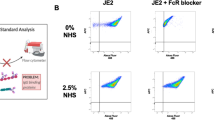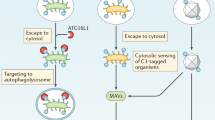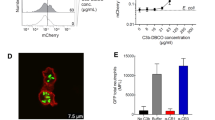Abstract
The complement system is pivotal in host defense but also contributes to tissue injury in several diseases. The assembly of C3 convertases (C4b2a and C3bBb) is a prerequisite for complement activation. The convertases catalyze C3b deposition on activator surfaces. Here we describe the identification of staphylococcal complement inhibitor, an excreted 9.8-kilodalton protein that blocks human complement by specific interaction with C4b2a and C3bBb. Staphylococcal complement inhibitor bound and stabilized C3 convertases, interfering with additional C3b deposition through the classical, lectin and alternative complement pathways. This led to a substantial decrease in phagocytosis and killing of Staphylococcus aureus by human neutrophils. As a highly active and small soluble protein that acts exclusively on surfaces, staphylococcal complement inhibitor may represent a promising anti-inflammatory molecule.
This is a preview of subscription content, access via your institution
Access options
Subscribe to this journal
Receive 12 print issues and online access
$209.00 per year
only $17.42 per issue
Buy this article
- Purchase on Springer Link
- Instant access to full article PDF
Prices may be subject to local taxes which are calculated during checkout







Similar content being viewed by others
Accession codes
References
Carroll, M.C. The complement system in regulation of adaptive immunity. Nat. Immunol. 5, 981–986 (2004).
Song, W.C., Sarrias, M.R. & Lambris, J.D. Complement and innate immunity. Immunopharmacology 49, 187–198 (2000).
Fujita, T. Evolution of the lectin-complement pathway and its role in innate immunity. Nat. Rev. Immunol. 2, 346–353 (2002).
Gasque, P. Complement: a unique innate immune sensor for danger signals. Mol. Immunol. 41, 1089–1098 (2004).
Rawal, N. & Pangburn, M.K. Formation of high affinity C5 convertase of the classical pathway of complement. J. Biol. Chem. 278, 38476–38483 (2003).
Xu, Y., Narayana, S.V. & Volanakis, J.E. Structural biology of the alternative pathway convertase. Immunol. Rev. 180, 123–135 (2001).
Holmskov, U., Thiel, S. & Jensenius, J.C. Collectins and ficolins: Humoral Lectins of the Innate Immune Defense. Annu. Rev. Immunol. 21, 547–578 (2003).
Moller-Kristensen, M., Thiel, S., Hansen, A.G. & Jensenius, J.C. On the site of C4 deposition upon complement activation via the mannan-binding lectin pathway or the classical pathway. Scand. J. Immunol. 57, 556–561 (2003).
Chen, C.B. & Wallis, R. Two mechanisms for mannose-binding protein modulation of the activity of its associated serine proteases. J. Biol. Chem. 279, 26058–26065 (2004).
De Bruijn, M.H. & Fey, G.H. Human complement component C3: cDNA coding sequence and derived primary structure. Proc. Natl. Acad. Sci. USA 82, 708–712 (1985).
Nakao, M., Matsumoto, M., Nakazawa, M., Fujiki, K. & Yano, T. Diversity of complement factor B/C2 in the common carp (Cyprinus carpio): three isotypes of B/C2-A expressed in different tissues. Dev. Comp. Immunol. 26, 533–541 (2002).
Ponnuraj, K. et al. Structural analysis of engineered Bb fragment of complement factor B: insights into the activation mechanism of the alternative pathway C3-convertase. Mol. Cell 14, 17–28 (2004).
Foster, T.J. The Staphylococcus aureus “superbug”. J. Clin. Invest. 114, 1693–1696 (2004).
De Haas, C.J. et al. Chemotaxis inhibitory protein of Staphylococcus aureus, a bacterial antiinflammatory agent. J. Exp. Med. 199, 687–695 (2004).
Rooijakkers, S.H.M., van Wamel, W.J.B., Ruyken, M., van Kessel, K.P.M. & van Strijp, J.A.G. Anti-opsonic properties of staphylokinase. Microbes Infect. 7, 476–484 (2005).
Jin, T. et al. Staphylococcus aureus resists human defensins by production of staphylokinase, a novel bacterial evasion mechanism. J. Immunol. 172, 1169–1176 (2004).
Rahimpour, R. et al. Bacterial superantigens induce down-modulation of CC chemokine responsiveness in human monocytes via an alternative chemokine ligand-independent mechanism. J. Immunol. 162, 2299–2307 (1999).
Dohlsten, M. et al. Immunopharmacology of the superantigen staphylococcal enterotoxin A in T-cell receptor Vβ3 transgenic mice. Immunology 79, 520–527 (1993).
Gladysheva, I.P., Turner, R.B., Sazonova, I.Y., Liu, L. & Reed, G.L. Coevolutionary patterns in plasminogen activation. Proc. Natl. Acad. Sci. USA 100, 9168–9172 (2003).
Leijh, P.C., van den Barselaar, M.T., Daha, M.R. & van Furth, R. Participation of immunoglobulins and complement components in the intracellular killing of Staphylococcus aureus and Escherichia coli by human granulocytes. Infect. Immun. 33, 714–724 (1981).
Neth, O., Jack, D.L., Johnson, M., Klein, N.J. & Turner, M.W. Enhancement of complement activation and opsonophagocytosis by complexes of mannose-binding lectin with mannose-binding lectin-associated serine protease after binding to Staphylococcus aureus. J. Immunol. 169, 4430–4436 (2002).
Cunnion, K.M., Lee, J.C. & Frank, M.M. Capsule production and growth phase influence binding of complement to Staphylococcus aureus. Infect. Immun. 69, 6796–6803 (2001).
Roos, A. et al. Functional characterization of the lectin pathway of complement in human serum. Mol. Immunol. 39, 655–668 (2003).
Seelen, M.A. et al. Functional analysis of the classical, alternative, and MBL pathways of the complement system: standardization and validation of a simple ELISA. J. Immunol. Methods 296, 187–198 (2005).
Servais, G., Walmagh, J. & Duchateau, J. Simple quantitative haemolytic microassay for determination of complement alternative pathway activation (AP50). J. Immunol. Methods 140, 93–100 (1991).
De Haas, C.J., van Leeuwen, H.J., Verhoef, J., Van Kessel, K.P.M. & Van Strijp, J.A.G. Analysis of lipopolysaccharide (LPS)-binding characteristics of serum components using gel filtration of FITC-labeled LPS. J. Immunol. Methods 242, 79–89 (2000).
De Haas, C.J., Haas, P.J., Van Kessel, K.P.M. & Van Strijp, J.A.G. Affinities of different proteins and peptides for lipopolysaccharide as determined by biosensor technology. Biochem. Biophys. Res. Commun. 252, 492–496 (1998).
Fearon, D.T. & Austen, K.F. Activation of the alternative complement pathway due to resistance of zymosan-bound. Proc. Natl. Acad. Sci. USA 74, 1683–1687 (1977).
Sahu, A. & Lambris, J.D. Structure and biology of complement protein C3, a connecting link between innate and acquired immunity. Immunol. Rev. 180, 35–48 (2001).
Fishelson, Z. & Muller-Eberhard, H.J. C3 convertase of human complement: enhanced formation and stability of the enzyme generated with nickel instead of magnesium. J. Immunol. 129, 2603–2607 (1982).
Laich, A. & Sim, R.B. Complement C4bC2 complex formation: an investigation by surface plasmon resonance. Biochim. Biophys. Acta 1544, 96–112 (2001).
Fearon, D.T. & Austen, K.F. Properdin: binding to C3b and stabilization of the C3b-dependent C3 convertase. J. Exp. Med. 142, 856–863 (1975).
Riedemann, N.C. & Ward, P.A. Complement in ischemia reperfusion injury. Am. J. Pathol. 162, 363–367 (2003).
Sahu, A. & Lambris, J.D. Complement inhibitors: a resurgent concept in anti-inflammatory therapeutics. Immunopharmacology 49, 133–148 (2000).
Nilsson, B. et al. Compstatin inhibits complement and cellular activation in whole blood in two models of extracorporeal circulation. Blood 92, 1661–1667 (1998).
Kaya, Z. et al. Contribution of the innate immune system to autoimmune myocarditis: a role for complement. Nat. Immunol. 2, 739–745 (2001).
Veldkamp, K.E., Heezius, H.C., Verhoef, J., van Strijp, J.A.G. & van Kessel, K.P.M. Modulation of neutrophil chemokine receptors by Staphylococcus aureus supernate. Infect. Immun. 68, 5908–5913 (2000).
Ponnuraj, K. et al. Structural analysis of engineered Bb fragment of complement factor B: insights into the activation mechanism of the alternative pathway C3-convertase. Mol. Cell 14, 17–28 (2004).
Haas, P.J. et al. N-terminal residues of the chemotaxis inhibitory protein of Staphylococcus aureus are essential for blocking formylated peptide receptor but not C5a receptor. J. Immunol. 173, 5704–5711 (2004).
Kaneko, J., Kimura, T., Narita, S., Tomita, T. & Kamio, Y. Complete nucleotide sequence and molecular characterization of the temperate staphylococcal bacteriophage phi PVL carrying Panton-Valentine leukocidin genes. Gene 215, 57–67 (1998).
Van Wamel, W.J.B., Van Rossum, G., Verhoef, J., Vandenbroucke-Grauls, C.M. & Fluit, A.C. Cloning and characterization of an accessory gene regulator (agr)-like locus from Staphylococcus epidermidis. FEMS Microbiol Lett. 163, 1–9 (1998).
Mollnes, T.E. et al. Essential role of the C5a receptor in E. coli-induced oxidative burst and phagocytosis revealed by a novel lepirudin-based human whole blood model of inflammation. Blood 100, 1869–1877 (2002).
He, S., Yang, J.C., Tsang, S., Sim, R.B. & Whaley, K. Role of the distal hinge region of C1-inhibitor in the regulation of C1s activity. FEBS Lett. 412, 506–510 (1997).
Ambrus, G. et al. Natural substrates and inhibitors of mannan-binding lectin-associated serine protease-1 and -2: a study on recombinant catalytic fragments. J. Immunol. 170, 1374–1382 (2003).
Schreiber, R.D., Pangburn, M.K., Lesavre, P.H. & Muller-Eberhard, H.J. Initiation of the alternative pathway of complement: recognition of activators by bound C3b and assembly of the entire pathway from six isolated proteins. Proc. Natl. Acad. Sci. USA 75, 3948–3952 (1978).
Acknowledgements
We thank W. Jansen for reviewing the manuscript, and L. de Graaf-Miltenburg for purification of factor B and C3. Supported by the European Union (LSHM-CT-2004-512093 and QLG1-CT-2001-01039).
Author information
Authors and Affiliations
Corresponding author
Ethics declarations
Competing interests
The authors declare no competing financial interests.
Supplementary information
Supplementary Fig. 1
Specificity of anti-SCIN antibodies. (PDF 92 kb)
Supplementary Fig. 2
SCIN interferes with formation and proteolytic activity of C3 convertases. (PDF 99 kb)
Rights and permissions
About this article
Cite this article
Rooijakkers, S., Ruyken, M., Roos, A. et al. Immune evasion by a staphylococcal complement inhibitor that acts on C3 convertases. Nat Immunol 6, 920–927 (2005). https://doi.org/10.1038/ni1235
Received:
Accepted:
Published:
Issue Date:
DOI: https://doi.org/10.1038/ni1235
This article is cited by
-
Genomic characterization of Staphylococcus aureus from Canastra Minas Artisanal Cheeses
Brazilian Journal of Microbiology (2023)
-
Interaction between Borrelia miyamotoi variable major proteins Vlp15/16 and Vlp18 with plasminogen and complement
Scientific Reports (2021)
-
Fungal dissemination is limited by liver macrophage filtration of the blood
Nature Communications (2019)
-
Genome investigations show host adaptation and transmission of LA-MRSA CC398 from pigs into Danish healthcare institutions
Scientific Reports (2019)
-
Interaction of host and Staphylococcus aureus protease-system regulates virulence and pathogenicity
Medical Microbiology and Immunology (2019)



